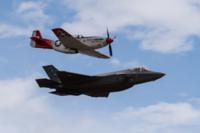At the height of the Cold War, U.S. Air Force scientists dreamed of a fleet of nuclear-powered aircraft. They almost made it happen.
It was 1955. The atomic power industry was maturing in the United States, and President Dwight Eisenhower had already made his call for "atoms for peace." The industrial race to domesticate the atom was underway.
The military race to employ our nation's defense was already more than 15 years old.
"Popular Mechanics" painted visions of a helpful "nuclear genie" that included everything from nuclear-powered excavation to atomic-powered homes. The atom was being trained to become man's best friend.
Meanwhile, the U.S. Navy had its nuclear-powered vessels like the USS Nautilus -- the Navy's first nuclear-powered submarine. Down the hall in the Pentagon, Air Force leaders wanted a nuclear-powered craft of their own for similar reasons -- unlimited range, power and endurance.
The interest in atomic-powered aircraft began in 1946 with the Nuclear Energy for the Propulsion of Aircraft (NEPA) program, managed by the Army Air Force and later the independent U.S. Air Force. By the end of 1948, the U.S. Air Force had invested nearly $10 million. While experts prepared extensive studies on their feasibility, actual aircraft development waited until after 1951 when the Aircraft Nuclear Propulsion (ANP) program replaced NEPA.
ANP aimed to "produce full-scale development aircraft reactor and engine systems" according to Brian Bikowicz, a nuclear history scholar. While Project Pluto successfully tested nuclear ramjets and Project Rover tested nuclear-powered rockets, an operational atomic aircraft was never actually developed.
"[M]anned nuclear aircraft pose the most difficult engineering development job yet attempted within this century," ANP Director B.C. Briant said in 1954.
The difficulty didn't stop the Air Force and its team of scientists from trying.
In 1952, the Air Force started the X-6 program to produce two flying testbeds powered by atomic energy. The Air Force chose a modified Convair B-36 "Peacemaker," designated the NB-36H. Only one of these special aircraft ever made it to testing -- Serial No. 51-5712, the Nuclear Test Aircraft (NTA).
The NB-36H carried a small air-cooled reactor in the aft bomb bay. The NTA had shielding around the reactor itself and a totally new nose section, which housed a 12-ton lead and rubber crew compartment. In the fuselage and behind the crew compartment, designers installed water jackets to absorb radiation. Due to the modifications, only the pilot and copilot could see through the foot-thick, leaded-glass windshield. A closed-circuit television system allowed the crew to check the reactor as well as other sections of the aircraft.
Between 1955 and 1957, the NTA made 47 test flights, yielding valuable data on the effects of radiation upon the airframes and components.
The United States had competition in creating atomic-powered aircraft. The Soviet Union operated a similar test program. One Soviet plan envisioned a "flying boat." In the plans for the aircraft, "the wingspan was more than 130 meters, and the total power of the engines exceeded one-half million horsepower. This airplane was supposed to carry 1,000 passengers and 100 tons of load at a speed of 1,000 kilometers per hour," according to R.G. Perelman in "Soviet Nuclear Propulsion" (1960).
In late 1958, "Aviation Week" reported that the Soviets successfully flew a prototype of an atomic-powered bomber. This report, accompanied by the general paranoia created by Sputnik and the enthusiasm of a technological race, temporarily fueled ANP to increased budgets.
But, the enthusiasm would not last. In the end, the program produced too few results over too long a period. The development of accurate and powerful missiles and the growing emphasis on space also lessened the appeal of atomic-powered aircraft.
On March 28, 1961, President John F. Kennedy canceled the ANP program, writing, "Nearly 15 years and about $1 billion have been devoted to the attempted development of a nuclear-powered aircraft; but the possibility of achieving a militarily useful aircraft in the foreseeable future is still very remote." Kennedy redirected much of the effort toward space and the race to reach the moon -- an effort and endeavor that captivated the American imagination, gained public support and eventually succeeded.
Want to Know More About the Military?
Be sure to get the latest news about the U.S. military, as well as critical info about how to join and all the benefits of service. Subscribe to Military.com and receive customized updates delivered straight to your inbox.















